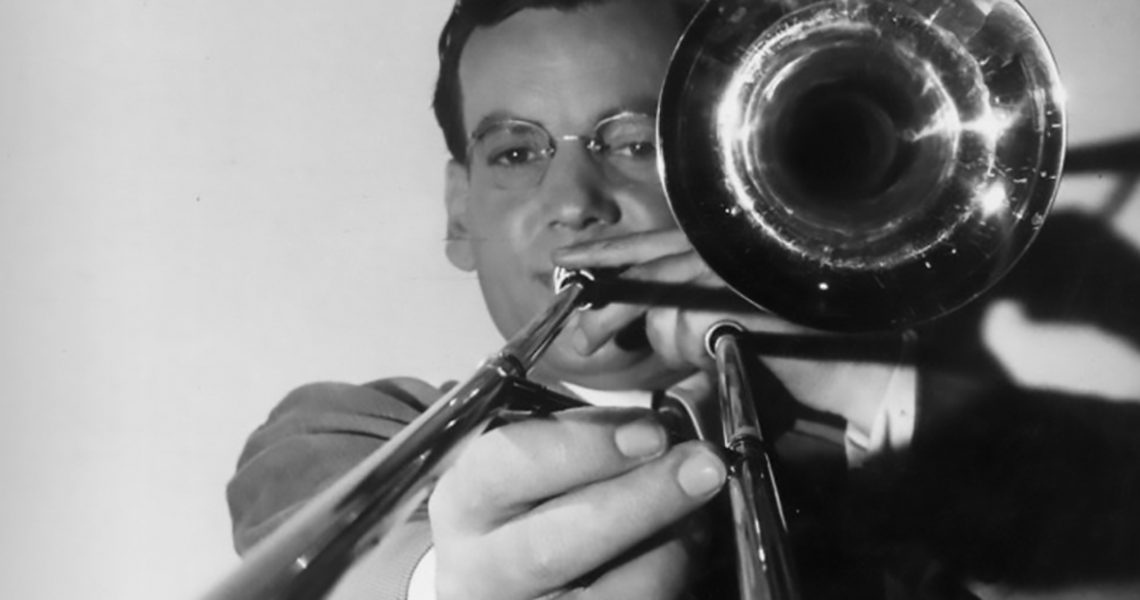And indeed, as the band grew in assurance, richness and power, this became one of its hallmarks. Miller, knowing his audiences had “slow ears,” tried to curb the more innovative solos of such players as Al Klink and, later trumpeter Billy May, who were truly original jazz men, but at the same time his fine ear for balance and structure led him to insist on, and encourage, solos that fit the surrounding ensembles and made sense within the arrangement. This is one reason why In the Mood and Little Brown Jug worked so well, and also why he was able to get so much mileage out of both fairly ordinary riff tunes like Pennsylvania 6-5000, A String of Pearls and Caribbean Clipper and such more complex charts as Johnson Rag, Anvil Chorus and Song of the Volga Boatmen, the latter written by Finegan and including a fugue in the middle.
As for May, he had a unique style of voicing and harmony that was very different from Miller, and although the leader was a bit wary about recording some of his charts he deeply respected his abilities and played them in live performances and broadcasts. Probably the most far-out May score was his late-1941 arrangement of the then-new song Blues in the Night, which turned up on LP in 1959 from a broadcast. May’s penchant for using diminished chords, atonal or modal harmonies, and voicings that gave both the brass and the saxes an edgy sound are all apparent here; from start to finish, this arrangement is a masterpiece. May also wrote a loping, medium-slow, two-beat arrangement of George Gershwin’s I Got Rhythm that sounded more like something a black band like Duke Ellington would play than Glenn Miller. Among the May charts that Miller did record were Long Tall Mama, a wonderful arrangement of Ida (Sweet as Apple Cider) featuring nice bass licks by Alpert and both a solo and vocal by Beneke, and I Dreamt I Dwelt in Harlem, the latter an ingenious variation on Billy Strayhorn’s Take the “A” Train, and of course Miller thought highly enough of May’s ability to ask him to come up with the minute-long bitonal introduction to Finegan’s Serenade in Blue arrangement. Yet although the Miller-May relationship was a bit strained, it was not because Glenn didn’t like his work; he just realized that it wasn’t commercial. When May tried to hand in his notice in the spring of 1942, Miller begged him to stay because he knew he was going to disband in late September to join the Army Air Force. Despite all the tensions he felt, May later said that Miller “helped me immensely. I learned a lot from Glenn. He was a good musician and an excellent arranger.”
The jazz critics of the day were quick to jump on Miller’s back for clipping his soloists’ wings and rehearsing his band like a drill sergeant, but he told them honestly, “I haven’t a great jazz band and I don’t want one. I don’t want to be the king of swing or anything else. I’d rather have a reputation as one of the best all-around bands…Our band stresses harmony. Eight brass and five reeds give you a lot of different sounds to work with…Stylization in music is inevitable. The style is the man…Would you say that Wagner wasn’t stylized? Is Ravel criticized for being Ravel?” The Miller sound, or more accurately sounds (he had about four of them), caught on so well and so quickly with the public at large that, by the end of 1939, his was the most popular big band in America, eclipsing even those of his friends Goodman and Dorsey.
Their reaction, wisely, was to regroup and re-emerge with a different sound and style. Goodman hired arrangers Eddie Sauter and Mel Powell, added Duke Ellington star Cootie Williams to his trumpet section, and ditched singer Martha Tilton, first for Helen Forrest and then for Peggy Lee. Tommy Dorsey hired a young singer who was starting to be noticed with the Harry James band, Frank Sinatra, and three arrangers to produce contrasting sounds, Axel Stordahl and Paul Weston for the medium-tempo and slow numbers featuring Sinatra and the Pied Pipers and then stealing jazz arranger Sy Oliver away from the Jimmie Lunceford band to write the jumping swing numbers.
At first, Miller resisted following Goodman and Dorsey into the field of ultra-slow romantic songs; it wasn’t really a part of him. Miller’s own recording of I’ll Never Smile Again was taken at a medium, bouncing tempo, but it utterly bombed alongside Tommy Dorsey’s slow, romantic arrangement by Sinatra, the Pied Pipers, a celesta, Dorsey’s trombone and the rhythm section. But Miller learned his lesson and, by the end of 1940, was following Dorsey into slow, lush ballads. These, too, became one of his trademarks.
By then, however, there was a serious rift between Miller and Dorsey. As soon as Miller paid off his debt to Dorsey instead of giving him a piece of his profits, the latter got mad and bankrolled a band using Glenn’s patented clarinet-led reed sound to compete with him. This band was led by a big, friendly, bear-like tenor saxist named Bob Chester, who had both talent and tons of personality. Dorsey wangled a Bluebird record contract for Chester, again to compete directly with Miller, but he should have known better. Miller, with his superior arranging skills and uncanny ability to judge the nation’s musical pulse, just kept pulling further out front. Chester did moderately well but wasn’t really stiff competition.
In the fall of 1940 he also hired Bobby Hackett as his regular rhythm guitarist and occasional trumpet soloist. Miller loved his inventive, scalar solos which fit in so perfectly with his new band concept. Hackett’s most famous recording with the band was the medium-uptempo A String of Pearls, but he made an even stronger impression on such slow numbers as Stardust, Rainbow Rhapsody, Rhapsody in Blue and the first chorus—after a startlingly inventive chromatic introduction written by Billy May—of Finegan’s arrangement of Serenade in Blue. At this time he also hired his finest bassist, Herman “Trigger” Alpert, whose superb rhythm and inventive spot solos invigorated the band, but for some reason Alpert left after only one year whereas Hackett stayed with the band until the end.
The Miller band’s two films for 20th-Century Fox, Sun Valley Serenade and Orchestra Wives, provide us with our only glimpse of the band in true stereo. The studio spared no experience in building a special soundstage for the band and insisting on Western Electric’s best sound system. The upside is that the original soundtracks, and recordings derived from it, are almost overwhelming in their impact. The downsides were that not every song they played for the films were included in them, and the tapes derived from the left-out songs are in mono (but very good, high-fidelity mono), and that not every theater that played the films had the proper sound equipment for the stereo sound to be appreciated. Because not all of the tracks existed in real stereo, none of them were issued in that format on LP or CD, but the VHS tapes and DVDs of the films include the true stereo sound. They also include some bits of the arrangements inexplicably omitted from the issued recordings, such as the full chorus of soft trombone playing in At Last.
Almost as soon as war was declared by President Roosevelt in December 1941, Miller applied for an application to the Army Air Force, but his application was ignored for months because he filled it out in his birth name, Alton. Glenn was his given middle name. Eventually the AAF realized who Alton Glenn Miller was and he was accepted. Miller broke up the civilian band in September of 1942 and immediately went to New Haven, Connecticut, where he spent a few months assembling the band he would bring overseas.
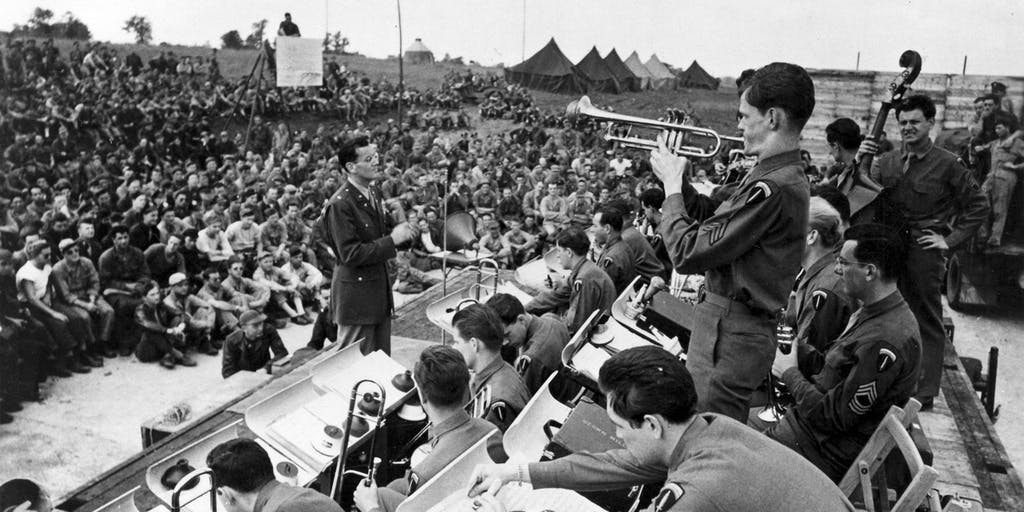
Surprisingly, only one of his civilian band members was chosen, and that was Trigger Alpert. The rest of the band consisted of musicians from other bands, among them trumpeters Bobby Nichols from the Vaughan Monroe band (he played the terrific solo on St. Louis Blues March) and Bernie Privin from Artie Shaw’s orchestra, clarinetist Michael “Peanuts” Hucko who had been with the Will Bradley-Ray McKinley band, McKinley himself on drums, and tenor saxist Vince Carbone. He also added something that Dorsey had done with his band but Miller had not with his civilian band, a full body of strings. Some listeners were disappointed by the results, particularly since Miller resorted to playing a lot of ballads, many of them in very bland, mood-music-style arrangements. But there were compensations. Ray Eberle’s somewhat tight tenor voice was replaced by the warmer, more relaxed singing of Johnny Desmond and Marion Hutton’s puerile voice was replaced by the up-and-coming Dinah Shore.
In addition, when the band did play jump tunes, some of them staples of his civilian band and some of them new to the repertoire (such as versions of Flying Home and Mission to Moscow superior to the Lionel Hampton and Benny Goodman originals and an almost surrealistic arrangement of Pistol Packin’ Mama), the band jumped even better than its civilian counterpart. Much of this was due to McKinley, whose drumming was even looser and more creative than Moe Purtill’s, but also to the gutsy, almost R&B-styled tenor solos of Carbone, Hucko’s inventive clarinet solos and the crackling trumpet playing of Nichols and Privin. Another surprise addition to the band was former Goodman pianist and arranger Mel Powell, who wrote a fascinating piece titled Pearls on Velvet that began as a mood piece but, after juxtaposing interspersed uptempo breaks with the soft string passages, suddenly broke out into a swing piece that used elements of both the string theme and the interspersed breaks to create a whole piece. Another benefit of the AAF band was that their performances were recorded in pristine high-fidelity sound by the best sound engineers in the service.
Miller’s disappearance, purportedly over the English Channel, in December 1944, has remained a great mystery, not the least of which was that the normally over-careful Miller threw caution to the winds and decided to go up anyway despite a raging thunderstorm that was sure to toss the light Norseman plane around. One of the more outlandish rumors being spread on the internet was that he was holed up in a Parisian brothel, where he got drunk and somehow met his end. This is beyond belief. Although Miller was known to be a nasty drunk, he purposely curtailed his drinking for that very reason, particularly when he was in the service, which he took very seriously. The most believable story comes from an American soldier stationed in Paris at the time, Fred Atkinson Jr., who claimed in 1999 that his buddies were sent out to investigate a plane crash, that they saw the bodies and identified them by their dogtags, and one of them was Glenn Miller. Atkinson claimed that the story was hushed up because one of the top military brass had overridden the order that the plane not take off that day due to the bad weather, and if it was investigated his name would come up and he might be court-martialed for reversing an Army decision. This would also explain why, when a British investigator tried to obtain access to the Army records pertaining to Miller’s disappearance in the 1980s, they were still sealed and would not be released.
Whatever the case, there is no question but that Glenn Miller was one of the most gifted and original arrangers of his day. In 1943, by which time he was already in the AAF, he published a book on arranging through Mutual Music because, as he put it in the preface, “Many comprehensive volumes have been written about harmony, theory, counterpoint, orchestration and composition, but to my knowledge, no book has ever been written which actually told how to make an arrangement.” As short as the book was—only 140 pages—it was quite thorough, starting out with a chart showing the possible range of each instrument in a jazz or dance orchestra, explaining that the term “possible” was given only insofar as the leader could obtain excellent performers who had that range. For the combination of clarinet and tenor saxes he warned the prospective arranger to “Avoid staccato passages as short notes do not permit sufficient duration for good blending of all voices,” while combining altos and tenors was “Suitable for legato or rhythmic melodies—background for solo instrument or solo voice—melodic line for modulations—introductions—interludes—endings—background rhythms and background sustained passages.” He then goes through a dozen different reed combinations, some including baritone saxophone, and explains the function and strengths of each of them. Similarly different voicings are explored for the trumpet and trombone sections, breaking each one down to its best-sounding combination and its suggested use. After that, he then explores more complex chord voicings using the full complement of eight brass as a unit, showing the best possible placement for each instrument within each chord; he even explains the best use of the cup or plunger mutes.
By page 52, he is exploring more sophisticated voicings for major or minor triads, 7th, 9th, 11th or 13th chords, and on p. 54 he gives you the natural harmonic series of the trombone (his own instrument) in order to explain how “the best method of doubling notes in a chord is that which conforms most closely to the natural harmonics of a ‘fixed wind column’” of that instrument. He then explains the best method of varying the rhythm section, how to intersperse ensemble or ad lib solo breaks into a drum solo, and then—finally—breaks down the creative process of creating an arrangement. For this, “If a tune has been chosen for you, but you consider it a poor tune, then accept it as a personal challenge to make a fine arrangement of it. There is no tune so bad that a wonderful arrangement won’t make it sound good.” He then shows you how to adapt, for instance, the piano part of the rather mundane Sylvia Lee song I’m Thrilled before going step-by-step through the process of creating an arrangement from introduction to final chorus, including where are the best places to insert modulations or coloristic effects. Samples of his charts of A String of Pearls and Keep ‘Em Flying are then printed out for study, along with excerpts from On the Old Assembly Line, Adios, Anvil Chorus, The Sprit is Willing, Sunrise Serenade, Tuxedo Junction and not one but two pages of score from the extraordinary Finegan-Miller arrangement of the first movement of Beethoven’s Moonlight Sonata, which despite the “desecration” of a piece of classical music I, and many others, consider to be one of his masterpieces. The latter is given here for your edification:
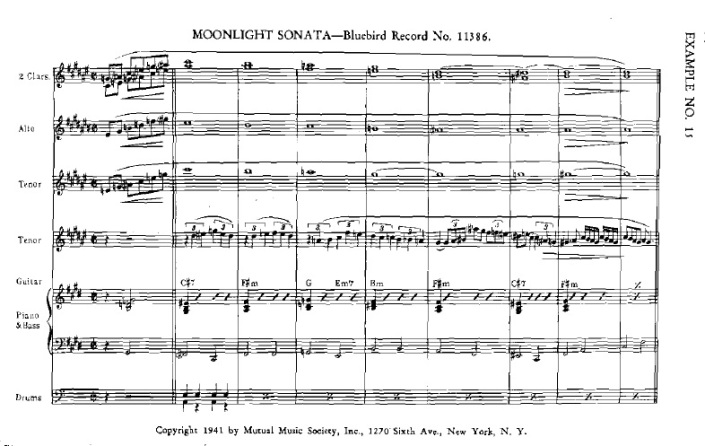
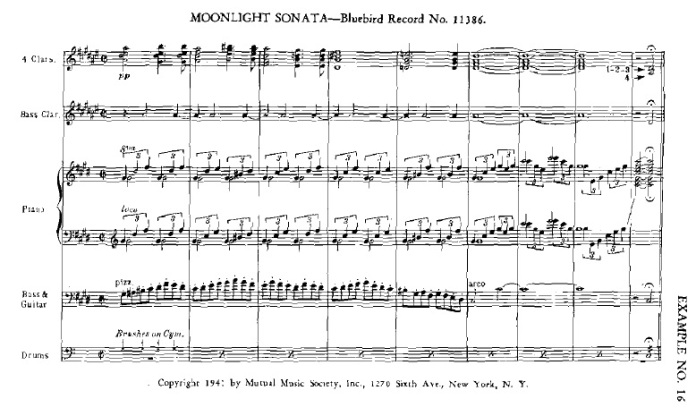
The rising chromatic brass coda to In the Mood is also included:
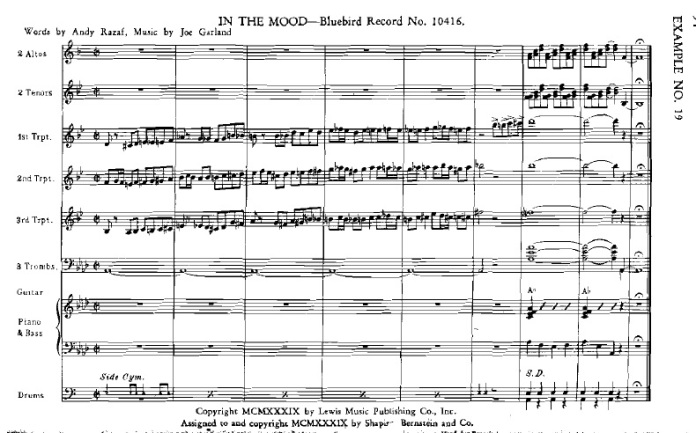
Unfortunately, so are a lot of ephemeral ballads, such as Yesterday’s Gardenias, Cradle Song and I’m Old-Fashioned, but c’est la vie. The book concludes with the full scores (hand-written and then photocopied) of I’m Thrilled and Song of the Volga Boatmen. Overall, this is still a valid and fairly comprehensive guide in how to arrange for a jazz-pop orchestra, and it helped a great many young arrangers who had little experience in working with this kind of an instrumental combination.
So there you have a somewhat comprehensive view of Glenn Miller’s musical mind, how it worked, and why I was so impressed as a youngster. Except for the fact that he only ventured occasionally into exotic harmonic territory, he was years ahead of virtually every other arranger of his time except for Ellington, Sauter and George Handy. Even the young Gil Evans, then working with Claude Thornhill, was only half-formed as an arranger-composer until the late 1940s. Miller was ahead of everyone else, and that is one reason why his recordings still exert an irresistible attraction even to younger listeners today.
—© 2019 Lynn René Bayley
Last modified: May 29, 2019


